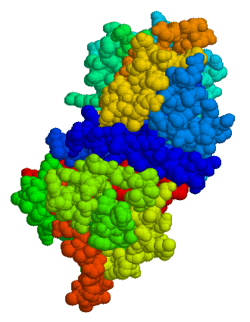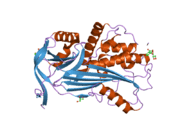C1-inhibitor
| View/Edit Human | View/Edit Mouse |
C1-inhibitor (C1-inh, C1 esterase inhibitor) is a protease inhibitor belonging to the serpin superfamily. Its main function is the inhibition of the complement system to prevent spontaneous activation.[4][5] C1-inhibitor is an acute-phase protein that circulates in blood at levels of around 0.25 g/L. The levels rise ~2-fold during inflammation. C1-inhibitor irreversibly binds to and inactivates C1r and C1s proteases in the C1 complex of classical pathway of complement. MASP-1 and MASP-2 proteases in MBL complexes of the lectin pathway are also inactivated. This way, C1-inhibitor prevents the proteolytic cleavage of later complement components C4 and C2 by C1 and MBL. Although named after its complement inhibitory activity, C1-inhibitor also inhibits proteases of the fibrinolytic, clotting, and kinin pathways. Note that C1-inhibitor is the most important physiological inhibitor of plasma kallikrein, fXIa, and fXIIa.
Proteomics
C1-inhibitor is the largest member among the serpin superfamily of proteins. It can be noted that, unlike most family members, C1-inhibitor has a 2-domain structure. The C-terminal serpin domain is similar to other serpins, which is the part of C1-inhibitor that provides the inhibitory activity. The N-terminal domain (also some times referred to as the N-terminal tail) is not essential for C1-inhibitor to inhibit proteases. This domain has no similarity to other proteins. C1-inhibitor is highly glycosylated, bearing both N- and O-glycans. N-terminal domain is especially heavily glycosylated.[5]
Genetics
The human C1-inhibitor gene (SERPING1) is located on the eleventh chromosome (11q11-q13.1).[6][7]
Role in disease
Deficiency of this protein is associated with hereditary angioedema ("hereditary angioneurotic edema"), or swelling due to leakage of fluid from blood vessels into connective tissue.[8] Deficiency of C1-inhibitor permits plasma kallikrein activation, which leads to the production of the vasoactive peptide bradykinin. Also, C4 and C2 cleavage goes unchecked, resulting in auto-activation of the complement system. In its most common form, it presents as marked swelling of the face, mouth and/or airway that occurs spontaneously or to minimal triggers (such as mild trauma), but such swelling can occur in any part of the body. In 85% of the cases, the levels of C1-inhibitor are low, while in 15% the protein circulates in normal amounts but it is dysfunctional. In addition to the episodes of facial swelling and/or abdominal pain, it also predisposes to autoimmune diseases, most markedly lupus erythematosus, due to its consumptive effect on complement factors 3 and 4. Mutations in the gene that codes for C1-inhibitor, SERPING1, may also play a role in the development of age related macular degeneration.[9]
Despite uncontrolled auto-activation, it is important to note that levels of key complement components are low during an acute attack, because they are being consumed - indeed, low levels of C4 are a key diagnostic test for hereditary angioedema. This situation is analogous to the low levels of clotting factors found in disseminated intravascular coagulation (DIC).
Classification
There are three types of C1 inhibitor deficiency:[10]
- Type I: Hereditary. Three of the four genes for C1 inhibitor are null genes, leading to low levels of C1 inhibitor.
- Type II: Hereditary. There are high levels of C1 inhibitor, but it is non-functional.
- Type III: Hereditary or acquired. Related to hormone levels in the body.
Therapeutic use
In hereditary angioedema
People with frequent attacks of angioedema are often treated using attenuated androgens, such as danazol and oxandrolone. Blood-derived C1-inhibitor may be more effective and does not carry the side-effects of danazol such as virilization and a risk of liver tumors, but does carry the risk associated with the use of any human blood product. Cinryze, a pharmaceutical-grade C1-inhibitor, was approved for the use of HAE in 2008. It was also the first C1-inhibitor approved for use in the United States.[11] It is a highly purified, pasteurized and nanofiltered plasma-derived C1 esterase inhibitor product; it has been approved for routine prophylaxis against angioedema attacks in adolescent and adult patients with HAE.[12]
A recombinant C1 inhibitor obtained from the milk of transgenic rabbits, conestat alfa (trade name Ruconest), is approved for the treatment of acute HAE attacks in adults.[13][14]
While C1 inhibitor therapy has been used acutely for more than 35 years in Europe in patients with C1 inhibitor deficiency, new methods of treating acute attacks have emerged: a plasma kallikrein inhibitor and the bradykinin receptor antagonist icatibant.
For other conditions
The activation of the complement cascade can cause damage to cells, therefore the inhibition of the complement cascade can work as a medicine in certain conditions.[15] When someone has a heart attack, for instance, the lack of oxygen in heart cells causes necrosis in heart cells: Dying heart cells spill their contents in the extracellular environment, which triggers the complement cascade. Activation of the complement cascade attracts phagocytes that leak peroxide and other reagents, which may increase the damage for the surviving heart cells. Inhibition of the complement cascade can decrease this damage.
Synthesis
C1-inhibitor is contained in the human blood; it can, therefore, be isolated from donated blood. Risks of infectious disease transmission (viruses, prions, etc.) and relative expense of isolation prevented widespread use. It is also possible to produce it by recombinant technology, but Escherichia coli (the most commonly used organism for this purpose) lacks the eukaryotic ability to glycosylate proteins; as C1-inhibitor is particularly heavily glycosylated, this asialylated recombinant form would have a short circulatory life (the carbohydrates are not relevant to the inhibitor function). Therefore, C1-inhibitor has also been produced in glycosylated form using transgenic rabbits.[16] This form of recombinant C1-inhibitor also has been given orphan drug status for delayed graft function following organ transplantation and for capillary leakage syndrome.[17]
References
- ↑ "Diseases that are genetically associated with SERPING1 view/edit references on wikidata".
- ↑ "Human PubMed Reference:".
- ↑ "Mouse PubMed Reference:".
- ↑ Davis AE (September 2004). "Biological effects of C1 inhibitor". Drug News Perspect. 17 (7): 439–46. doi:10.1358/dnp.2004.17.7.863703. PMID 15514703.
- 1 2 Cicardi M, Zingale L, Zanichelli A, Pappalardo E, Cicardi B (November 2005). "C1 inhibitor: molecular and clinical aspects". Springer Semin. Immunopathol. 27 (3): 286–98. doi:10.1007/s00281-005-0001-4. PMID 16267649.
- ↑ Theriault A, Whaley K, McPhaden AR, Boyd E, Connor JM (April 1990). "Regional assignment of the human C1-inhibitor gene to 11q11-q13.1". Hum. Genet. 84 (5): 477–9. doi:10.1007/BF00195824. PMID 2323781.
- ↑ Carter PE, Duponchel C, Tosi M, Fothergill JE (April 1991). "Complete nucleotide sequence of the gene for human C1 inhibitor with an unusually high density of Alu elements". Eur. J. Biochem. 197 (2): 301–8. doi:10.1111/j.1432-1033.1991.tb15911.x. PMID 2026152.
- ↑ Davis AE (January 2008). "Hereditary angioedema: a current state-of-the-art review, III: mechanisms of hereditary angioedema". Ann. Allergy Asthma Immunol. 100 (1 Suppl 2): S7–12. doi:10.1016/S1081-1206(10)60580-7. PMID 18220146.
- ↑ Ennis S, Jomary C, Mullins R, Cree A, Chen X, Macleod A, Jones S, Collins A, Stone E, Lotery A (November 2008). "Association between the SERPING1 gene and age-related macular degeneration: a two-stage case-control study". Lancet. 372 (9652): 1828–34. doi:10.1016/S0140-6736(08)61348-3. PMID 18842294.
- ↑ Gompels, MM; Lock, RJ; Abinun, M; Bethune, CA; Davies, G; Grattan, C; Fay, AC; Longhurst, HJ; et al. (2005). "C1 inhibitor deficiency: consensus document" (pdf). Clinical and experimental immunology. 139 (3): 379–94. doi:10.1111/j.1365-2249.2005.02726.x. PMC 1809312
 . PMID 15730382. Retrieved 2010-05-17.
. PMID 15730382. Retrieved 2010-05-17. - ↑ "Approval History, Letters, Reviews and Related Documents - CINRYZE". Retrieved 2015-01-21.
- ↑ Drugs.com: Cinryze
- ↑ Drugs.com: Ruconest 2100 U powder for solution for injection
- ↑ Summary of product characteristics for Ruconest
- ↑ Caliezi C, Wuillemin WA, Zeerleder S, Redondo M, Eisele B, Hack CE (March 2000). "C1-Esterase inhibitor: an anti-inflammatory agent and its potential use in the treatment of diseases other than hereditary angioedema". Pharmacol. Rev. 52 (1): 91–112. PMID 10699156.
- ↑ Koles K, van Berkel PH, Pieper FR, Nuijens JH, Mannesse ML, Vliegenthart JF, Kamerling JP (January 2004). "N- and O-glycans of recombinant human C1 inhibitor expressed in the milk of transgenic rabbits". Glycobiology. 14 (1): 51–64. doi:10.1093/glycob/cwh010. PMID 14514717.
- ↑ Bernstein JA (January 2008). "Hereditary angioedema: a current state-of-the-art review, VIII: current status of emerging therapies". Ann. Allergy Asthma Immunol. 100 (1 Suppl 2): S41–6. doi:10.1016/S1081-1206(10)60585-6. PMID 18220151.
Further reading
- Lappin D, Whaley K (1989). "Regulation of C1-inhibitor synthesis by interferons and other agents". Behring Inst. Mitt. (84): 180–92. PMID 2478116.
- Stein PE, Carrell RW (1995). "What do dysfunctional serpins tell us about molecular mobility and disease?". Nat. Struct. Biol. 2 (2): 96–113. doi:10.1038/nsb0295-96. PMID 7749926.
- Davis AE, Bissler JJ, Cicardi M (1994). "Mutations in the C1 inhibitor gene that result in hereditary angioneurotic edema". Behring Inst. Mitt. (93): 313–20. PMID 8172583.
- Davis AE (2005). "The pathophysiology of hereditary angioedema". Clin. Immunol. 114 (1): 3–9. doi:10.1016/j.clim.2004.05.007. PMID 15596403.
- Siddique Z, McPhaden AR, McCluskey D, Whaley K (1992). "A single base deletion from the C1-inhibitor gene causes type I hereditary angio-oedema". Hum. Hered. 42 (4): 231–4. doi:10.1159/000154075. PMID 1339401.
- Davis AE, Aulak K, Parad RB, et al. (1993). "C1 inhibitor hinge region mutations produce dysfunction by different mechanisms". Nat. Genet. 1 (5): 354–8. doi:10.1038/ng0892-354. PMID 1363816.
- Frangi D, Aulak KS, Cicardi M, et al. (1992). "A dysfunctional C1 inhibitor protein with a new reactive center mutation (Arg-444-->Leu)". FEBS Lett. 301 (1): 34–6. doi:10.1016/0014-5793(92)80204-T. PMID 1451784.
- Lappin DF, Guc D, Hill A, et al. (1992). "Effect of interferon-gamma on complement gene expression in different cell types". Biochem. J. 281 (Pt 2): 437–42. doi:10.1042/bj2810437. PMC 1130704
 . PMID 1531292.
. PMID 1531292. - Siddique Z, McPhaden AR, Lappin DF, Whaley K (1992). "An RNA splice site mutation in the C1-inhibitor gene causes type I hereditary angio-oedema". Hum. Genet. 88 (2): 231–2. doi:10.1007/bf00206079. PMID 1684567.
- Frangi D, Cicardi M, Sica A, et al. (1991). "Nonsense mutations affect C1 inhibitor messenger RNA levels in patients with type I hereditary angioneurotic edema". J. Clin. Invest. 88 (3): 755–9. doi:10.1172/JCI115373. PMC 295456
 . PMID 1885769.
. PMID 1885769. - Carter PE, Duponchel C, Tosi M, Fothergill JE (1991). "Complete nucleotide sequence of the gene for human C1 inhibitor with an unusually high density of Alu elements". Eur. J. Biochem. 197 (2): 301–8. doi:10.1111/j.1432-1033.1991.tb15911.x. PMID 2026152.
- Parad RB, Kramer J, Strunk RC, et al. (1990). "Dysfunctional C1 inhibitor Ta: deletion of Lys-251 results in acquisition of an N-glycosylation site". Proc. Natl. Acad. Sci. U.S.A. 87 (17): 6786–90. doi:10.1073/pnas.87.17.6786. PMC 54622
 . PMID 2118657.
. PMID 2118657. - Stoppa-Lyonnet D, Carter PE, Meo T, Tosi M (1990). "Clusters of intragenic Alu repeats predispose the human C1 inhibitor locus to deleterious rearrangements". Proc. Natl. Acad. Sci. U.S.A. 87 (4): 1551–5. doi:10.1073/pnas.87.4.1551. PMC 53513
 . PMID 2154751.
. PMID 2154751. - Levy NJ, Ramesh N, Cicardi M, et al. (1990). "Type II hereditary angioneurotic edema that may result from a single nucleotide change in the codon for alanine-436 in the C1 inhibitor gene". Proc. Natl. Acad. Sci. U.S.A. 87 (1): 265–8. doi:10.1073/pnas.87.1.265. PMC 53243
 . PMID 2296585.
. PMID 2296585. - Theriault A, Whaley K, McPhaden AR, et al. (1990). "Regional assignment of the human C1-inhibitor gene to 11q11-q13.1". Hum. Genet. 84 (5): 477–9. doi:10.1007/BF00195824. PMID 2323781.
- Aulak KS, Cicardi M, Harrison RA (1990). "Identification of a new P1 residue mutation (444Arg----Ser) in a dysfunctional C1 inhibitor protein contained in a type II hereditary angioedema plasma". FEBS Lett. 266 (1–2): 13–6. doi:10.1016/0014-5793(90)81494-9. PMID 2365061.
- Skriver K, Radziejewska E, Silbermann JA, et al. (1989). "CpG mutations in the reactive site of human C1 inhibitor". J. Biol. Chem. 264 (6): 3066–71. PMID 2563376.
- Ariga T, Igarashi T, Ramesh N, et al. (1989). "Type I C1 inhibitor deficiency with a small messenger RNA resulting from deletion of one exon". J. Clin. Invest. 83 (6): 1888–93. doi:10.1172/JCI114095. PMC 303909
 . PMID 2723063.
. PMID 2723063. - Tosi M, Duponchel C, Bourgarel P, et al. (1986). "Molecular cloning of human C1 inhibitor: sequence homologies with alpha 1-antitrypsin and other members of the serpins superfamily". Gene. 42 (3): 265–72. doi:10.1016/0378-1119(86)90230-1. PMID 3089875.


